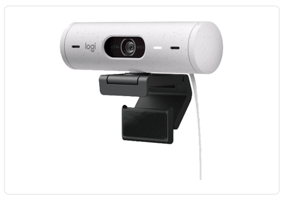Headsets and earbuds offer similar use cases but in very different form factors. Whether you’re...
Inside-Out vs. Outside-In Tracking Cameras Explained
![]()
As remote and hybrid workspaces become increasingly commonplace, using state-of-the-art video conferencing systems is critical for communicating and collaborating seamlessly. Camera systems that use positional tracking technology are vital in enhancing virtual meetings by keeping all participants visible and fully engaged.
Two unique tracking methods accomplish similar results in distinct ways—inside-out and outside-in. The camera’s position and the room’s size and layout are key factors in determining whether an inside-out or outside-in approach is better for your setup.
As an AV company with over two decades of experience, you can count on us to provide expert guidance. Inside-out tracking might be the perfect solution, or you may find that taking an outside-in approach makes more sense. Here’s everything you need to know.
Inside-Out: A Brief Overview
With an inside-out system, the room and participants are tracked by sensors contained within the primary camera. External tracking hardware isn’t required, as the tracking features are already integrated into the all-in-one device itself.
Key Features
- Built-In Sensors: The cameras have onboard sensors, such as infrared cameras, wide-angle lenses, and depth sensors that track movements and signal the device to make adjustments in real-time.
- Self-Contained: Cameras with inside-out tracking center on their own position, allowing for simple deployment with no additional peripherals needed.
- Automatic Adjustments: These systems use an intelligent tracking camera with algorithms powered by AI and machine learning that automatically adjust framing, zoom, and focus based on the movements and activities of meeting participants.
Outside-In: A Brief Overview
Outside-in tracking systems rely on external cameras or sensors that are positioned in strategic locations throughout the workspace. These peripherals capture a broad perspective of the entire room, providing more coverage for enhanced precision and multiple angles.
Key Features
- External Peripherals: In contrast to self-contained inside-out tracking cameras, outside-in systems use external cameras or sensors.
- Full-Room Coverage: Due to the positioning and quantity of the sensors, outside-in systems capture a larger field of view.
- Multiple Tracking Points: Outside-in systems are ideal for large rooms or workspaces with unusual layouts or dynamic presentations with moving participants.
Evaluating Both Positional Tracking Approaches
Now that you’re familiar with the fundamentals, let’s compare and contrast both approaches across different criteria, with a strong focus on video conferencing systems.
1. Setup and Deployment Difficulty
- Inside-Out: Because the sensors are integrated into the camera itself, getting started is usually simple and straightforward, even for non-technical users. Additionally, many cameras with inside-out tracking are designed to be plug-and-play.
- Outside-In: Since multiple external cameras or sensors are needed, the system may need to be carefully positioned and calibrated. This can be challenging and time-consuming, and some setups may require professional assistance to get up and running optimally.
2. Coverage and Field of View
- Inside Out: Given that the intelligent tracking camera is self-contained, there’s an intrinsic limit to its coverage. These cameras are typically best suited for small to medium rooms where participants are positioned in a defined area.
- Outside-In: Because outside-in tracking systems use multiple external sensors, they provide a larger field of view that’s ideal for larger rooms, unique room configurations, and rooms where people might move around during the meeting.
3. Positional Tracking Accuracy
- Inside Out: As inside-out tracking cameras depend on onboard sensors and AI-powered algorithms, tracking precision may suffer if the environment is too large or if participants move around quickly.
- Outside-In: Since external sensors and cameras capture a larger field of view and multiple angles, they can typically triangulate participants’ positions more accurately.
4. Scalability and Versatility
- Inside-Out: Due to the sensors being integrated into the cameras themselves, they usually perform best with fixed tabletop configurations and may not be able to adapt to nontraditional workspaces and meetings.
- Outside-In: Because the sensors are external, outside-in systems scale more effectively than inside-out tracking cameras, as you can simply add more peripherals as needed to expand coverage.
5. Price
- Inside-Out: A single intelligent tracking camera is typically more economical than a comprehensive video conferencing system.
- Outside-In: Outside-in tracking systems tend to be larger investments because they require more hardware, and in some circumstances, professional installation and configuration.
Comparing Camera Positions
![]()
Where the camera is placed in the room plays a major role in the video conferencing experience, as its position directly affects the visibility and engagement of meeting participants. While configurations can vary widely, center-of-table is the most common placement for inside-out tracking systems; outside-in systems usually use a surrounding-the-table placement.
Center-of-Table
Definition: The camera is positioned in the center of the meeting room table.
Pros
- Simplicity: With just one self-contained camera, an inside-out system with a center-of-table placement is as straightforward as it gets.
- Smart Adjustments: AI-powered algorithms can signal the camera frame, zoom, and focus in real-time, keeping participants clearly visible.
- Form Factor: Many inside-out cameras have sleek, compact, and lightweight designs that fit seamlessly into most environments.
Cons
- Limited Range: A center-of-table placement may not provide adequate coverage for larger rooms or complex setups. Participants sitting far away or at extreme angles may not be visible with inside-out tracking systems.
Surrounding-the-Table
Definition: The table is surrounded by cameras and sensors that provide full room coverage.
Pros
- Comprehensive Coverage: Outside-in tracking systems are able to capture a larger area and more participants.
- Multiple Perspectives: Strategically positioned cameras can capture the environment from various angles.
- Dynamic Capture: Outside-in positional tracking systems are especially adept at capturing moving participants and transitions.
Cons
- Complexity: Installing and positioning multiple peripherals may require professional assistance.
- Price: Outside-in systems tend to be more expensive.
Which Tracking Setup Should You Choose?
By now, you probably have an idea of whether you should choose an inside-out tracking camera or opt for an outside-in system. Here’s a quick guide to the key factors to keep in mind.
1. Workspace Size and Layout
- Small to Medium Rooms: Inside-out systems are ideal for small rooms and medium rooms with standard layouts.
- Larger Rooms and Complex Layouts: Outside-in systems provide better coverage for larger spaces and rooms with unusual layouts.
2. Participant Dynamics
- Static Participants: Inside-out systems perform best when participants remain seated in the same position during the meeting.
- Moving Participants: Outside-in systems can better track moving participants or interactive presentations.
3. Budget Requirements
- Limited Spending Power: An inside-out tracking camera may meet your needs at a more economical price point.
- High Spending Power: An outside-in tracking camera system can provide a better experience, but may require a larger investment.
Call for a Free Consultation
Positional tracking can be a game-changer, but only if you choose the right hardware and have it configured properly. From basic webcams to complex setups with multiple cameras, our in-house AV specialists are standing by to answer your questions about video conferencing equipment.
Contact us for a free, 10-minute consultation. We can custom-build a comprehensive outside-in system that meets your unique needs, or we can recommend an intelligent tracking camera for a straightforward inside-out tracking system. Find your perfect solution at Chester Springs AV.




